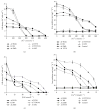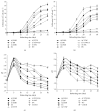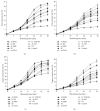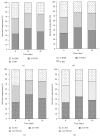Cross-comparison of leaching strains isolated from two different regions: Chambishi and Dexing copper mines
- PMID: 25478575
- PMCID: PMC4248400
- DOI: 10.1155/2014/787034
Cross-comparison of leaching strains isolated from two different regions: Chambishi and Dexing copper mines
Abstract
A cross-comparison of six strains isolated from two different regions, Chambishi copper mine (Zambia, Africa) and Dexing copper mine (China, Asia), was conducted to study the leaching efficiency of low grade copper ores. The strains belong to the three major species often encountered in bioleaching of copper sulfide ores under mesophilic conditions: Acidithiobacillus ferrooxidans, Acidithiobacillus thiooxidans, and Leptospirillum ferriphilum. Prior to their study in bioleaching, the different strains were characterized and compared at physiological level. The results revealed that, except for copper tolerance, strains within species presented almost similar physiological traits with slight advantages of Chambishi strains. However, in terms of leaching efficiency, native strains always achieved higher cell density and greater iron and copper extraction rates than the foreign microorganisms. In addition, microbial community analysis revealed that the different mixed cultures shared almost the same profile, and At. ferrooxidans strains always outcompeted the other strains.
Figures





Similar articles
-
Effective bioleaching of low-grade copper ores: Insights from microbial cross experiments.Bioresour Technol. 2020 Jul;308:123273. doi: 10.1016/j.biortech.2020.123273. Epub 2020 Mar 30. Bioresour Technol. 2020. PMID: 32247948
-
The bioleaching potential of a bacterial consortium.Bioresour Technol. 2016 Oct;218:659-66. doi: 10.1016/j.biortech.2016.07.012. Epub 2016 Jul 6. Bioresour Technol. 2016. PMID: 27416516
-
Adhesion forces between cells of Acidithiobacillus ferrooxidans, Acidithiobacillus thiooxidans or Leptospirillum ferrooxidans and chalcopyrite.Colloids Surf B Biointerfaces. 2012 Jun 1;94:95-100. doi: 10.1016/j.colsurfb.2012.01.022. Epub 2012 Jan 27. Colloids Surf B Biointerfaces. 2012. PMID: 22341516
-
Bioleaching of chalcopyrite concentrate by a moderately thermophilic culture in a stirred tank reactor.Bioresour Technol. 2009 Jan;100(2):515-20. doi: 10.1016/j.biortech.2008.06.033. Epub 2008 Jul 25. Bioresour Technol. 2009. PMID: 18657418 Review.
-
Extracellular polymeric substances mediate bioleaching/biocorrosion via interfacial processes involving iron(III) ions and acidophilic bacteria.Res Microbiol. 2006 Jan-Feb;157(1):49-56. doi: 10.1016/j.resmic.2005.07.012. Epub 2005 Dec 15. Res Microbiol. 2006. PMID: 16431087 Review.
References
-
- Bevilaqua D., Acciari H. A., Benedetti A. V., Garcia O. J. Electrochemical techniques used to study bacterial-metal sulfides interactions in acidic environment. In: Donati E. R., Wolfgang S., editors. Microbial Processing of Metal Sulfides. Dordrecht, The Netherlands: Springer; 2007. pp. 59–76.
-
- Rohwerder T., Sand W. Microbial Processing of Metal Sulfides. Springer; 2007. Mechanisms and biochemical fundamentals of bacterial metal sulfide oxidation; pp. 35–38.
-
- Vera M., Schippers A., Sand W. Progress in bioleaching: fundamentals and mechanisms of bacterial metal sulfide oxidation—part A. Applied Microbiology and Biotechnology. 2013;97:7529–7541. - PubMed
Publication types
MeSH terms
Substances
LinkOut - more resources
Full Text Sources
Other Literature Sources
Medical

